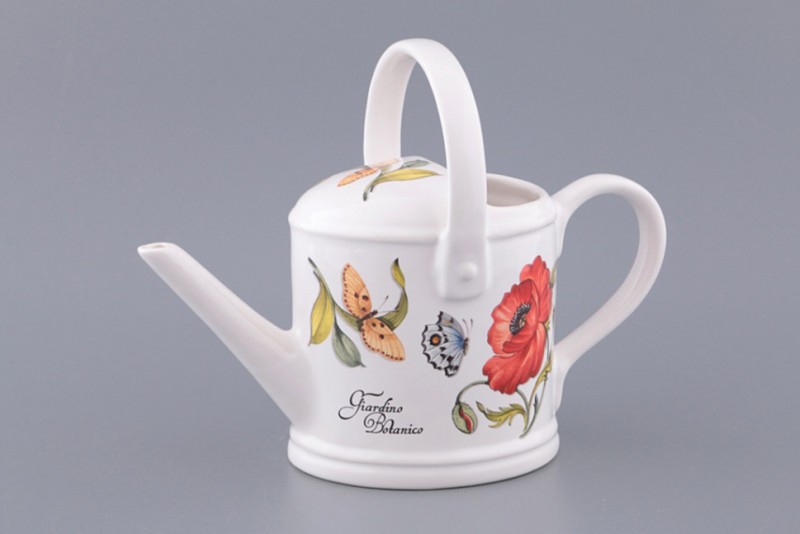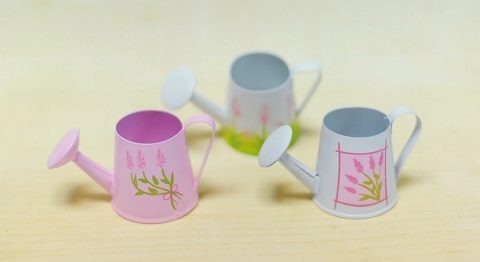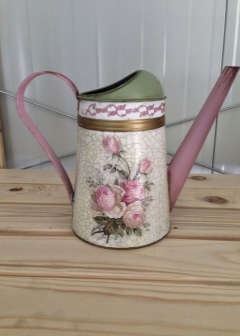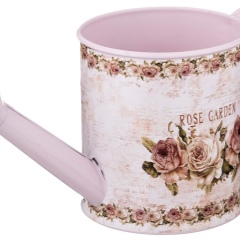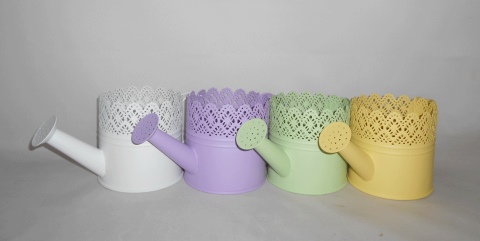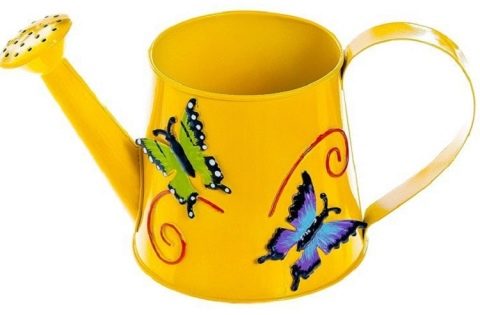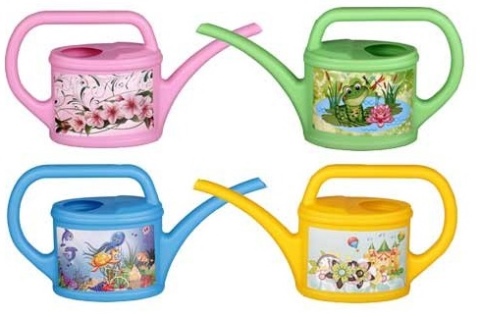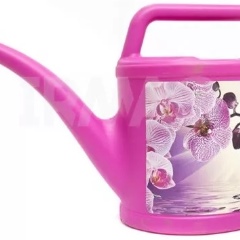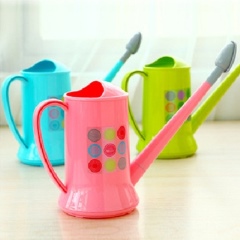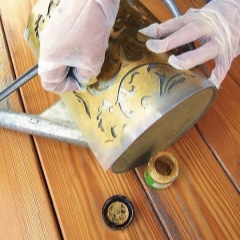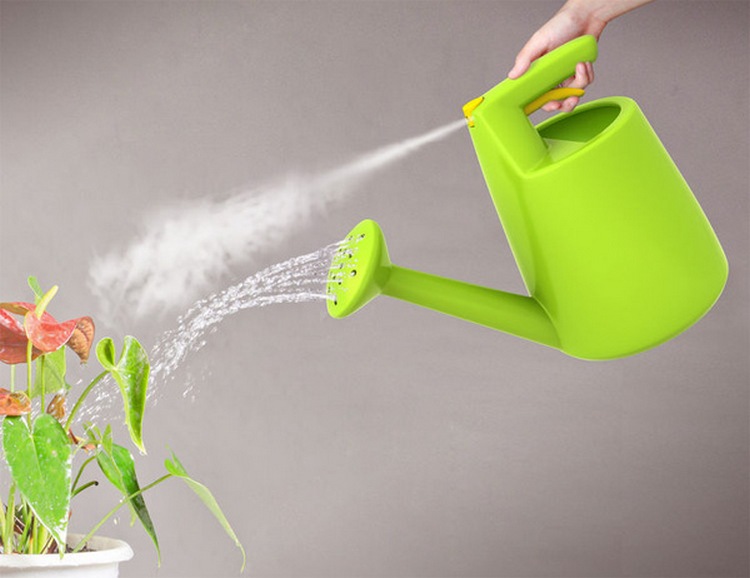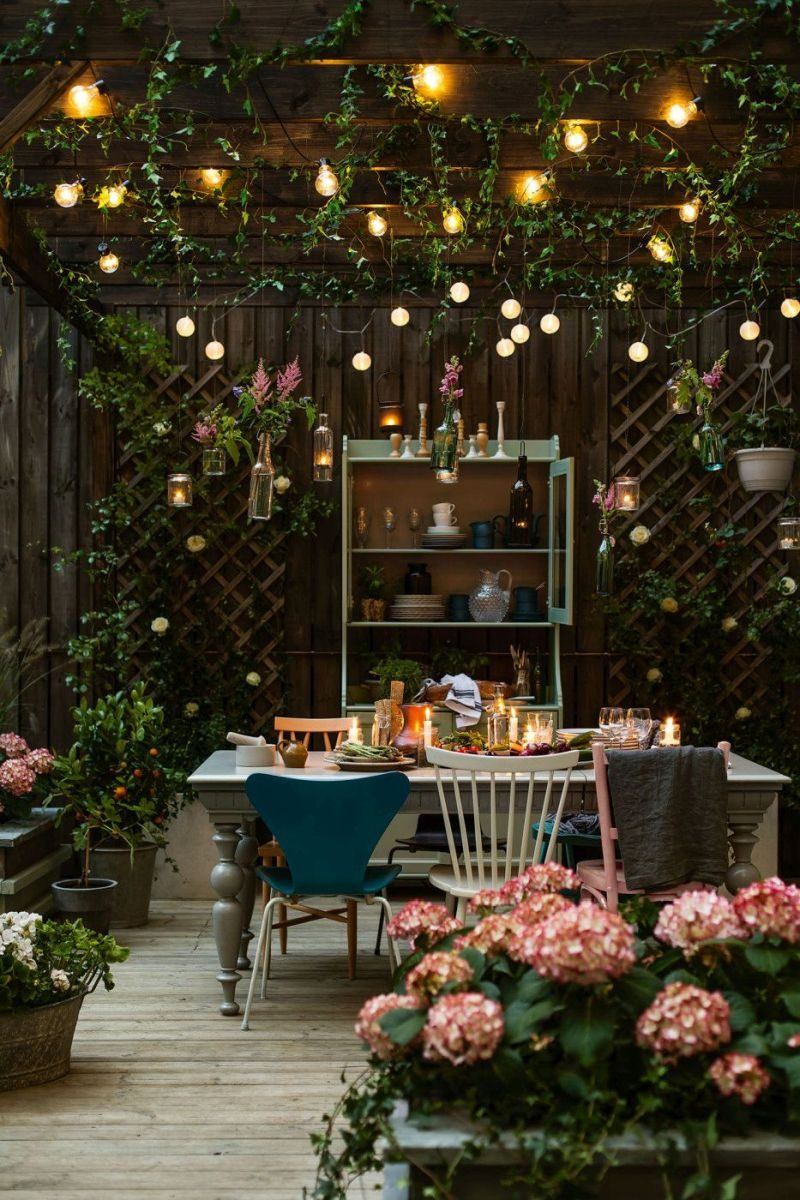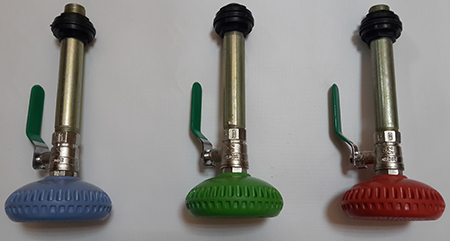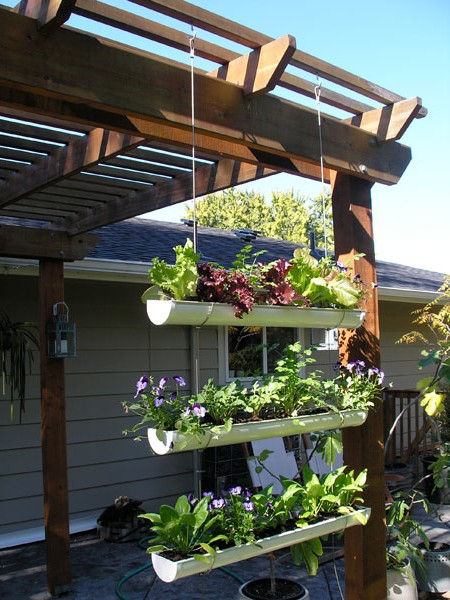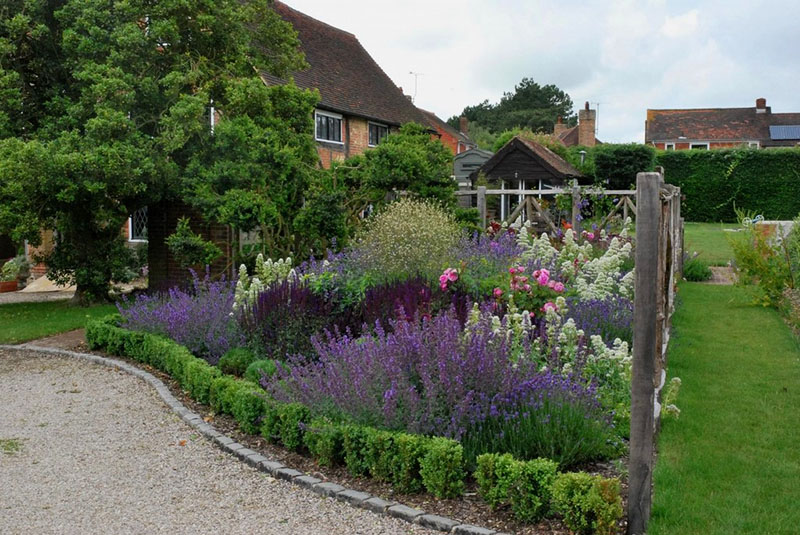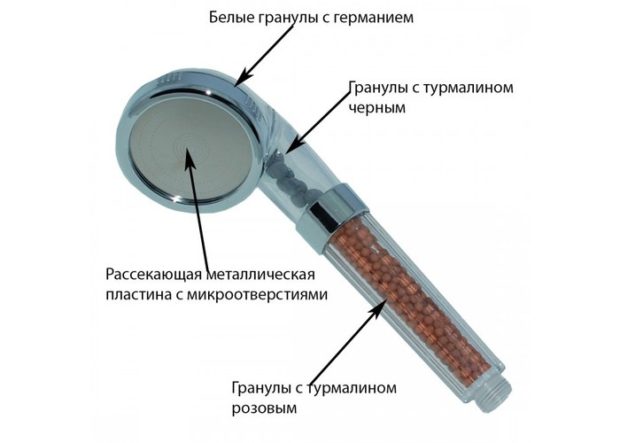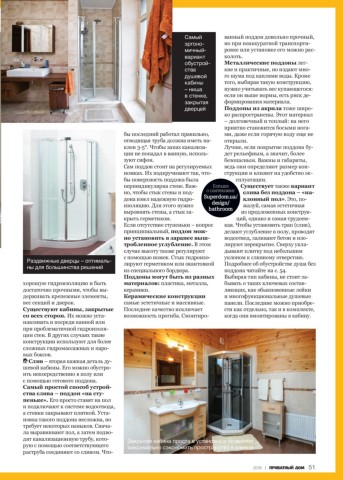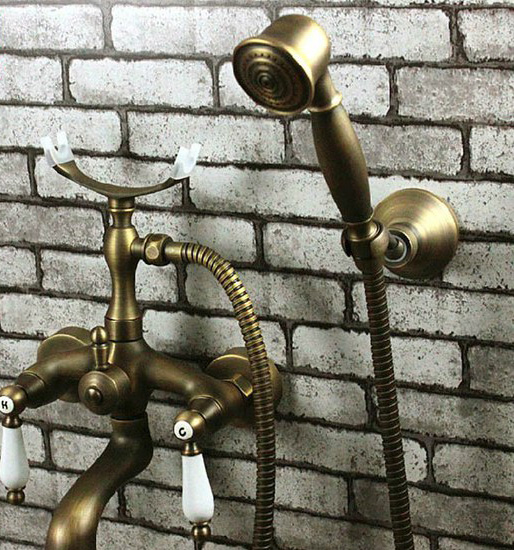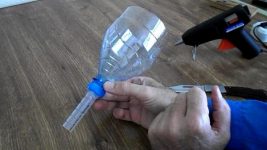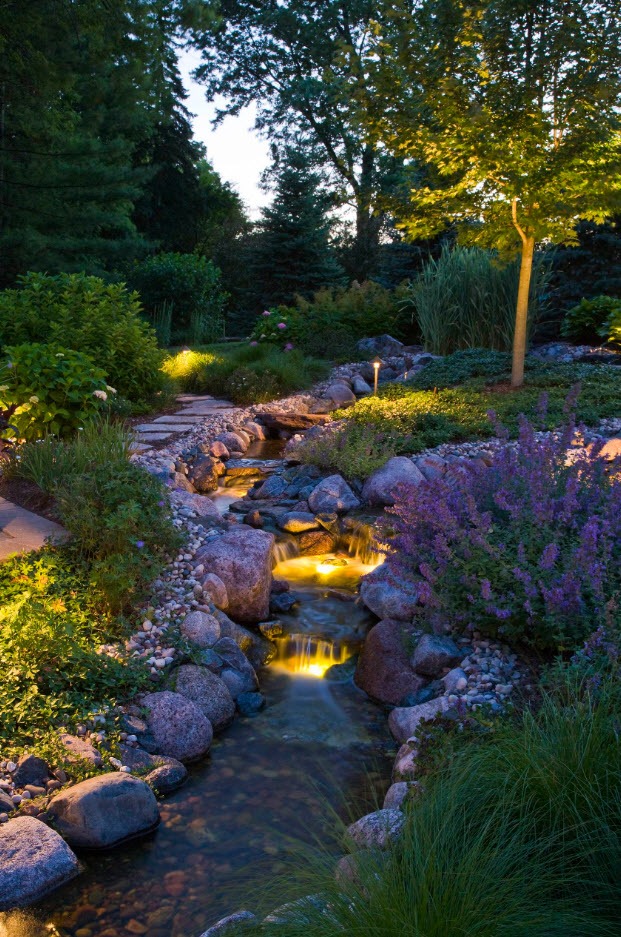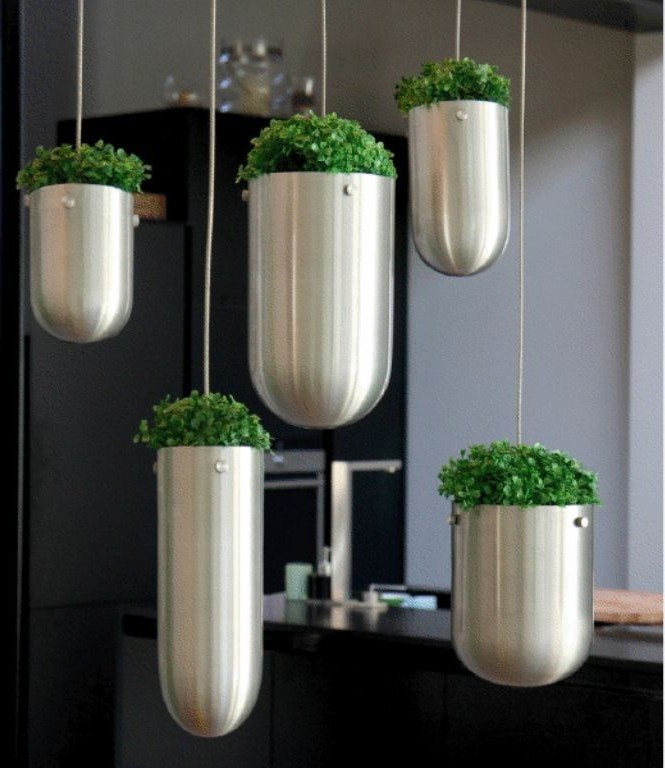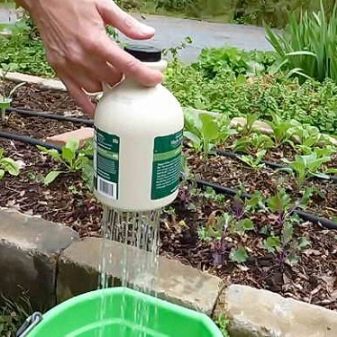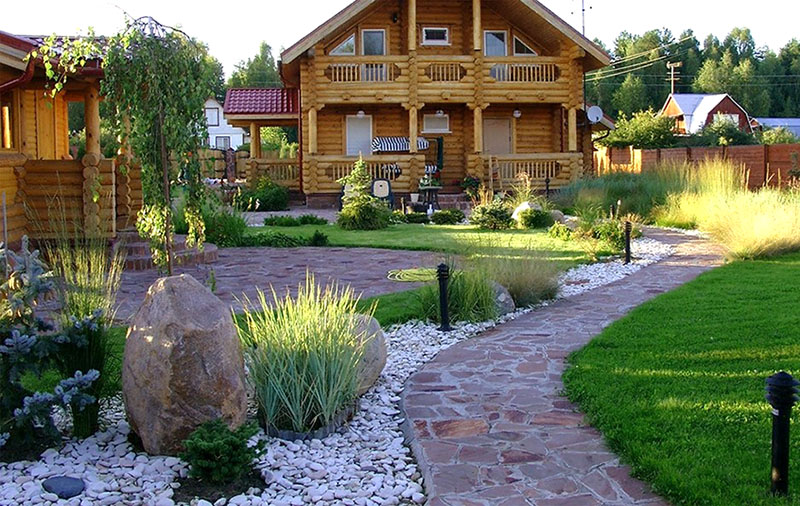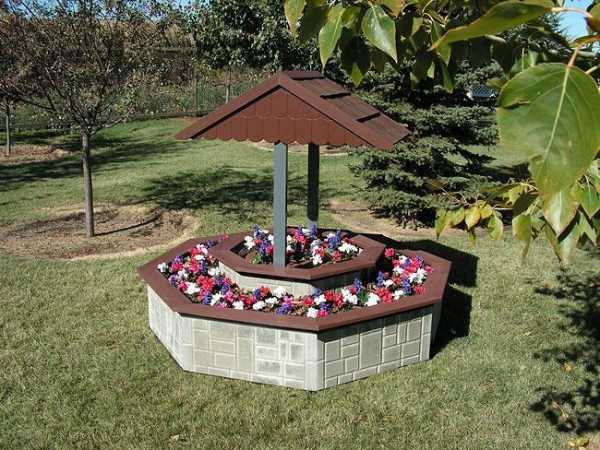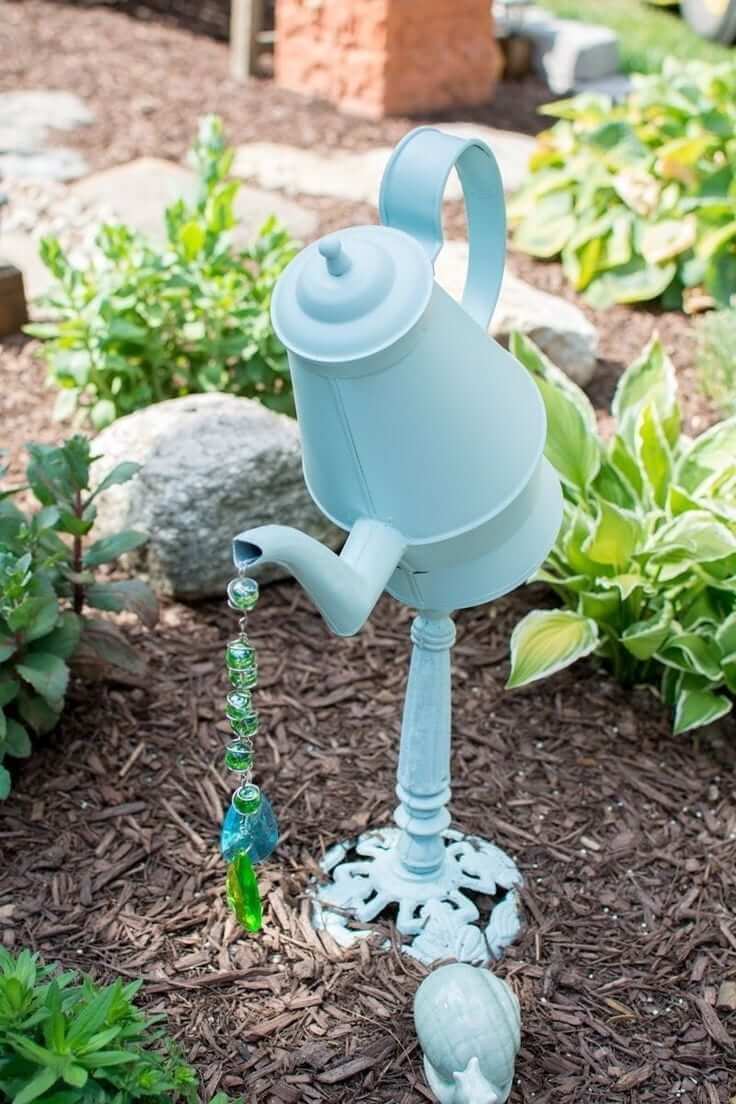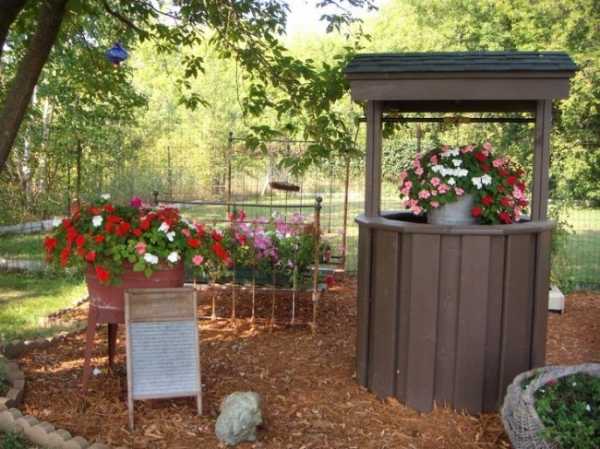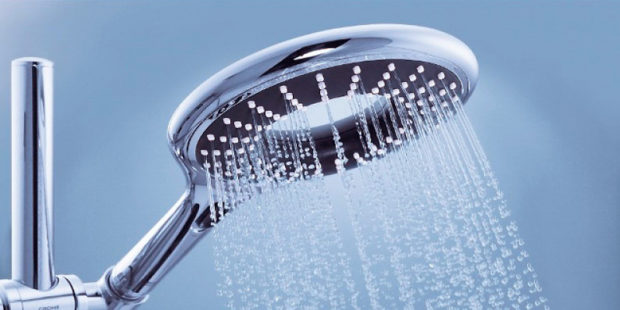Differences between decorative and ordinary
It is quite easy to recognize a decorative watering can. Outwardly, it is very different from the usual one due to the following features.
- Small size. Usually the volume of decorative options does not exceed 2 liters. However, beautiful large garden specimens decorated with original plots can also be attributed to this group.
- Ease. Small size usually means light weight. The lightest of all decorative mini-watering cans are plastic options.
- More aesthetic appearance. In most cases, in the manufacture of decorative watering cans, the main bias is made on its appearance, rather than on the main functional purpose.
- A variety of design solutions and techniques are used for decoration. In this case, decoration can be carried out both at work and at home.
- Can be used as a vase or flowerpot. In this case, a substitution of functionality is used - an original design solution that is popular with buyers.
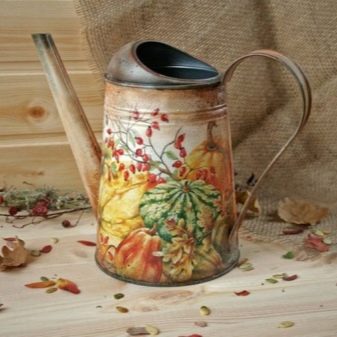
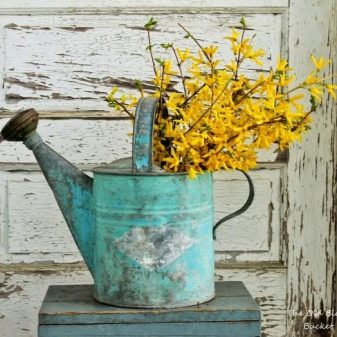
Materials (edit)
Metal
Decorative watering cans made of thin metal are the most accurate copy of the usual garden version. For the manufacture of small metal watering cans, as a rule, stainless metals or steel with a special anti-corrosion coating are used. They are great for both interior decoration and for watering potted plants.
Ceramics
Ceramic watering cans are usually more streamlined and look more like decorative figurines. This model is easy to turn into a vase for fresh cut flowers or to plant a houseplant in it. Ceramic specimens weigh much more than plastic ones, about the same as decorative metal options.

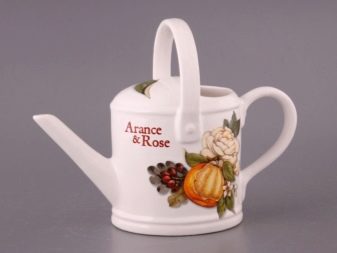
Master classes
Decorating a metal watering can
By itself, this garden item is pretty boring. In order to turn a metal watering can into an elegant, even luxurious object, you will need: brushes, napkins with the selected image, acrylic paints, varnish, glue, and solvent.
The step-by-step algorithm is as follows:
- prepare the base: wash and dry thoroughly;
- degrease with alcohol or solvent, glass cleaner is suitable;
- priming the watering can with white acrylic paint in 2-3 layers;
- apply a layer of paint of the required color for the base of the composition;
- if necessary, we use bituminous varnish to create the impression of an aged thing, it is applied in those places where this effect is needed: seams, pits;
- after a quarter of an hour, we soak a cloth in a solvent and wipe the varnished places, it should not be completely dry by this time;
- free the layer with the image of the picture from the rest of the layers of the napkin;
- we tear off the drawing itself, without clear outlines, but neatly;
- choose a place on the watering can where the image will be located, coat with PVA glue;
- put a napkin on the main side and iron it from the middle to the edges with a brush so as not to break;
- we wait until everything dries up, make the necessary details, adjustments, add strokes, dots, ornaments, lines as needed;
- apply acrylic varnish on the watering can in at least two layers, dry.
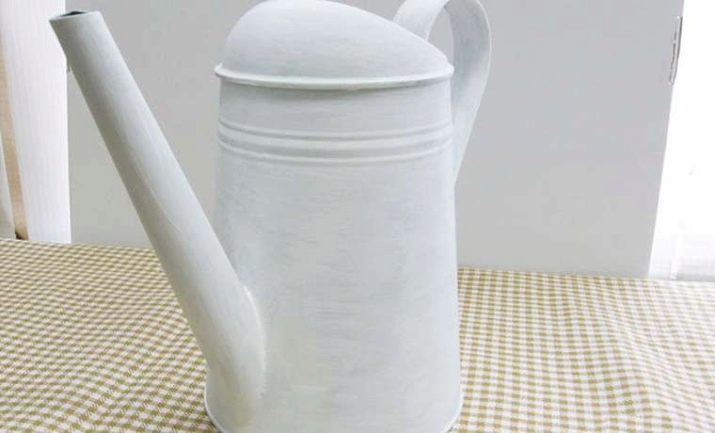
Shabby chic
You will need: acrylic paints, brushes, wax, a watering can and the necessary pattern on napkins.
A watering can is carried out in the style of "shabby" luxury as follows:
- we prepare the base: wash, dry, degrease;
- primed with white acrylic paint;
- we choose the places of aging and after drying with three of them with wax;
- apply the main pigment;
- rub with sandpaper or sandpaper;
- we glue the decor in the same way as in the previous master class;
- we tint with varnish.
Plastic product design
The procedure for registering a plastic product is as follows:
- we prepare the surface, wash it for this, dry it and degrease it with any detergent or alcohol using a sponge;
- we sand the base with fine-grain sandpaper in order to further improve the possibilities for hitching;
- we sand the damaged areas, scratches in the most thorough way;
- primed with acrylic varnish in several layers, at least 20 minutes should pass between their application;
- paint over with the selected pigment and leave to dry;
- apply crackle to pre-selected places, dry the first layer for a quarter of an hour;
- we proceed to the second stage of staining with pigment, you can choose a different shade, let it dry;
- then again the line for craquelure, after which, using a hot hairdryer, dry, characteristic cracks should appear;
- prepare images for decoupage, cut them out, separate the lower layers;
- we apply glue to where the decoupage motive is planned to be placed;
- glue the drawing, iron it with a brush;
- we cover the entire product with acrylic-based varnish, dry it, this procedure must be repeated at least three times;
- we turn over the drawing with thin brushes, making the final touches.
The master class can be viewed in the following video.
What materials are they made of?
On the shelves of modern stores, there is a tool made of various materials:
- ceramics;
- metal;
- plastic.
Ceramics are distinguished by their durability, lack of reaction with water (regardless of its pH level). There are vacuum tools that are filled with water, then the upper hole is closed with a finger, thereby, in accordance with the laws of physics, the water is kept inside. When it is necessary to water the plant, the finger is pulled back and the liquid is poured out through the lower holes. The only drawback of such a product can be considered the fragility of the structure, since upon impact, the ceramics will fly into pieces.
Metal watering cans do not break when dropped, they are durable, but if they are made of low-quality material, they will rust over time. They are presented on the market in a wide variety: there are colored enamel models and simple tin ones. Such tools are popular due to their affordable cost.
In the first place in popularity are plastic watering cans, since they are inexpensive, of high quality, do not break when dropped, do not rust. Manufacturers offer an unprecedented variety of shapes and colors. These are almost always cast products, the construction of which has no seams or joints, which avoids leakage. The only thing worth remembering is that you need to store such a tool away from sunlight, since thin plastic under their influence can deform and fade.
Buying Tips
When buying such household equipment, experts advise paying attention not only to the material from which the watering can was made, but also to other indicators, which include:
- volume;
- convenience;
- spout design;
- the weight.
Weight matters when you have to water more than one plant, but many
The user should pay attention to whether it will be convenient to hold the watering can not only with two, but also with one hand. The position and shape of the handle also affects the ergonomics of the product.
There are such models on sale in which the distance between the body and the handle is too small, so the hand is not so easy to squeeze through, and if this is done, then a trace remains. In order not to be disappointed in the purchase, you should immediately check the convenience of the watering can design. The most optimal option in terms of volume is no more than three liters, for indoor flowers it is also suitable for 1.5 liters.
It is desirable that the spout of the watering can be rather long. So it will be easier to push it under the wide foliage of indoor plants, minimally traumatizing it.There are products with a curved design of the spout and a straight one, there is no significant difference at the time of operation, just a curved one allows watering further from the central stem.
The best models for irrigation are those that have a small distributor at the end of the watering can, that is, irrigation is obtained not by point, but by scattered irrigation. The soil around the flower is better wetted, moisture is distributed evenly, no funnels form in the soil.
More expensive models include a spray system as a nice addition. The fine-dispersed spray gun allows you to replace the second tool and will help to produce high-quality spraying of the flower.
The spraying system is located above the spout, which is very convenient and allows you to simultaneously perform two tasks. The spray arm is located under the handle, this design guarantees maximum user comfort. Water is supplied from the same department where irrigation is carried out.
A ceramic watering can also serve as an additional decorative element, but when using it, it is worth remembering that the material is not only more expensive than others, but also rather fragile. Such products are always equipped with a thin spout and do not have a distributor at the end, so the liquid is supplied in a small stream. In contrast, plastic models look more attractive, moreover, it is not always easy to find a ceramic watering can on sale.
For information on how to choose the most convenient watering can for seedlings and indoor flowers, see the next video.
Flowerbed of tires
Long-lasting mobile flower beds are easy to create in old tires. They are arranged in a different order, creating interesting multi-row flowering designs.
Craftsmen cut out original figures, flower pots from obsolete tires, which are painted or painted with ornamental patterns. Such options become a magnificent decoration of the site.

By tying a car tire to a tree, you will get a stylish round flowerpot

A simple idea for a bright mood

Suspended flower bed made of tires

Tire beds in the form of funny characters will create a cheerful and joyful mood
What else to consider when choosing
- Any watering can that is used in the garden should be stable, with a wide neck and a spout that extends almost from the base.
- If you plan to breed feedings in a watering can, it is worth purchasing a model with graduated divisions in order to comply with the "recipe".
- For spraying plants, you just need a watering can with a spray.
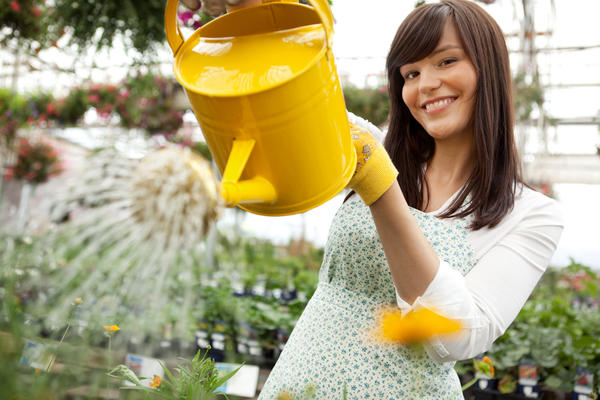
But the most important recommendation for those who choose a watering can is, perhaps, "Choose a watering can by yourself!" This is indeed the case. We are all different, we have different tastes, and we do not always love the same plants. Therefore, the watering cans will be different. What models do you prefer?
published on
according to the materials
Specifications
Today, manufacturers of garden tools offer customers models of watering cans made of different materials - metal and plastic. Each individual variety has a number of advantages and some disadvantages. Before making a choice in favor of a particular design, you should get acquainted with each representative of watering can in more detail.
The general name of the metal watering can implies the use in the production of various metals.
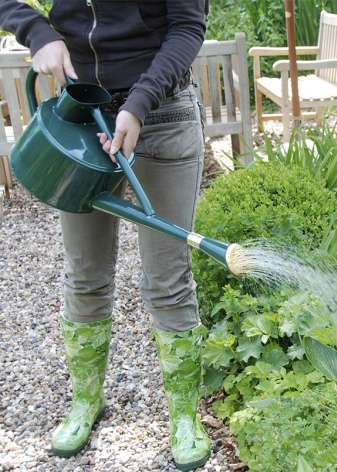
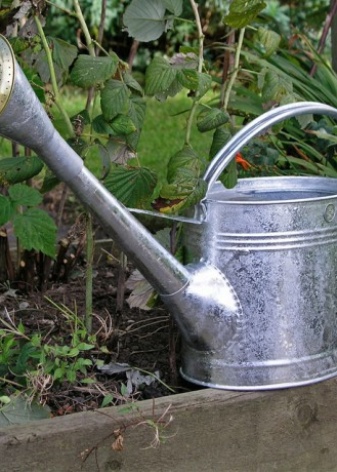
It can be galvanized steel or regular sheet metal. It is quite easy to distinguish them, it is enough to look with the naked eye at the offered product. Galvanized models have a natural metal sheen. But the hand sprinkler, made of sheet iron, is always painted as a protective cover against corrosion.
But unfortunately, such processing cannot completely protect the device from rusting. After a certain time, from the combination of water and metal, the watering can leak and flow.The most vulnerable spots in metal watering cans are the connecting seams. Despite the strong welding, it is in these parts that the first holes mostly occur. But if such problems appear, the metal structure can be repaired, for example, an additional seam can be made.

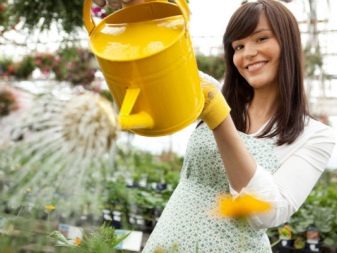
Another drawback that a metal sprinkler has is its weight. The device, made of metal, already has a large mass, and if you pour water into it to the maximum level, the watering can will become physically unmanageable.
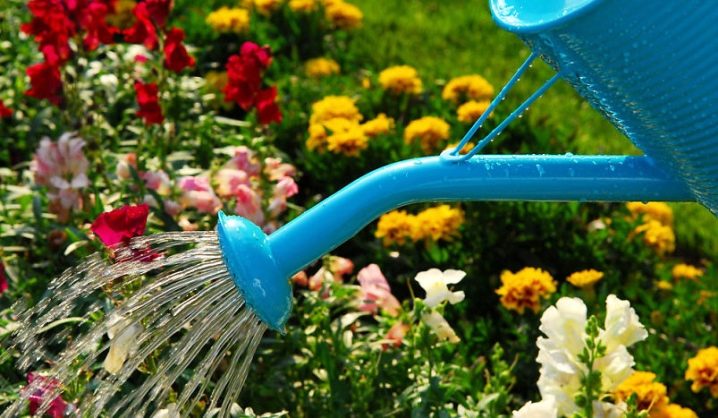
Against the background of metal devices, a plastic watering can may seem very preferable, but this is only at first glance. Many gardeners quite often faced the problem of deformation of the irrigation device, and all due to excess weight of water and changes in climatic temperature.
In the production of these products, different types of plastic are used. It can be polypropylene and polyethylene. Polypropylene is exposed to an external negative factor. The deformation of this material occurs even from direct sunlight. It follows from this that you should not give your preference to such watering cans. Polyethylene, in turn, is the highest quality material and is much more reliable in terms of technical progress.
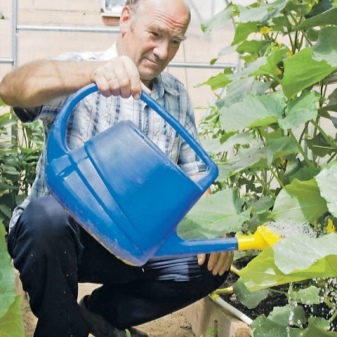
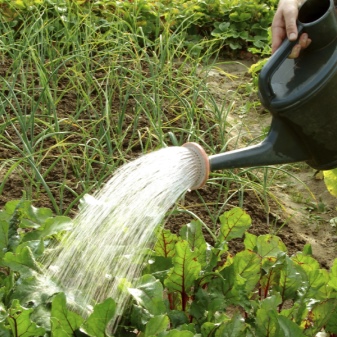
Next, you should pay attention to the size of the watering cans. Of course, the model is selected individually for each person, but as a universal watering device that will be used by all family members, you should pay attention to the volume
It is very easy for a healthy and physically strong man to carry a 10 or 12 liter container in his hands, but it is best for a woman to use models with a maximum volume of 9 liters. The most acceptable diameter of the spout should be 2.5 cm, otherwise the water pressure will be very strong, accordingly, watering will be done carelessly.
Creating a composition
Pots and containers for the composition are chosen wide in diameter to fit many elements. In this case, the height of the flowerpot should be from 10 to 20 cm, otherwise the plants may not take root.
Before filling the pot with flower soil, you need to take care of drainage - be sure to lay pebbles, crushed stone or expanded clay on the bottom. The height of the drainage is no more than 4 cm. Only then can the container be filled with a substrate, taking care of the density of the layer. The soil is placed a few centimeters below the edge of the pot.
In the project of the future miniature garden, all types of plants that are planned for planting should be immediately envisaged. Each of them needs a matching flower primer. To do this, determine the places in the pot for different types of soil, then separate them by laying out paths of pebbles.
After planting the plants, they create a pond, steps, houses, and place decorative elements.
Is it worth breaking the pots
This is the case when overlapped flowerpots will come in handy. They are suitable for an unusual multi-tiered composition. A potted garden with a missing side part is created in a cascade manner. Broken parts of the flowerpot are used for "number of storeys" and steps. After filling with soil, suitable plants are planted on each tier, decorated with decorative items. Small pots with plants are placed at different levels.
Types of decor
Volumetric images
The volumetric image on a small watering can is created using a special shape or hand sculpting. As conceived by the artist, it can be a flower arrangement, an animal or any other image. Colored modeling or monochromatic composition is allowed.
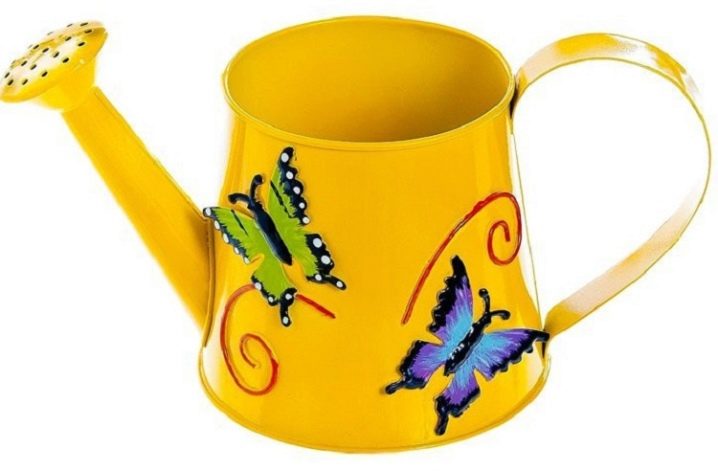
Drawing
Decorative patterns with a pattern are often painted by hand using a brush and special paints. Also, stencils, sponges and a spray can of paint are used to create an original design for the garden option.
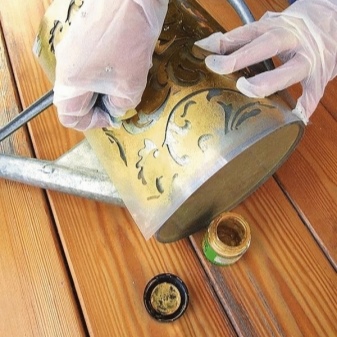
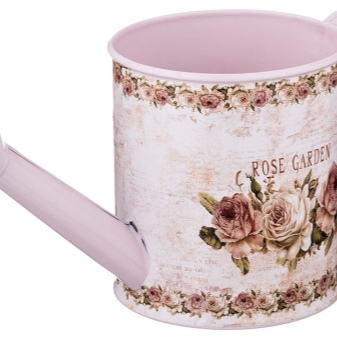
Decoupage
Decoupage is a technique for decorating products using cut-out images.For decoupage decorative watering cans use colored napkins with different themes or cut out the so-called applique from colored paper. To transfer the neatly cut image to the surface, it is glued and varnished.
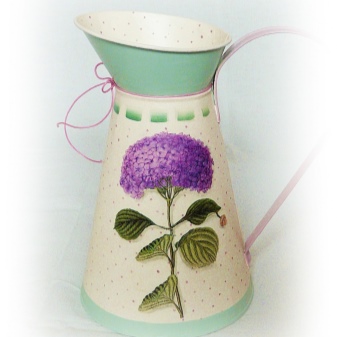
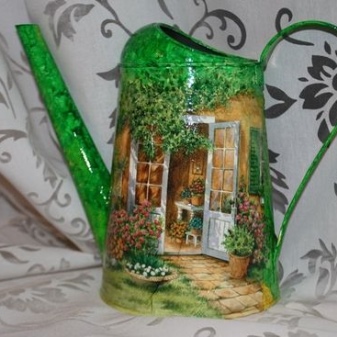
Stickers
Manufacturers often use stickers to decorate plastic watering cans. However, in this way, you can decorate any model with a smooth surface. To do this, you need to purchase stickers with the pattern you like and carefully, peeling off the protective base, transfer them to a decorative watering can.
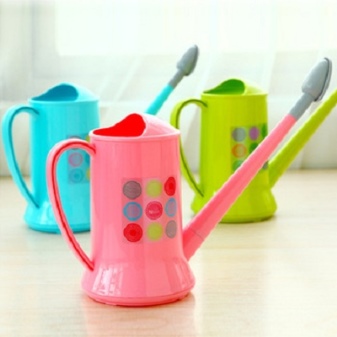
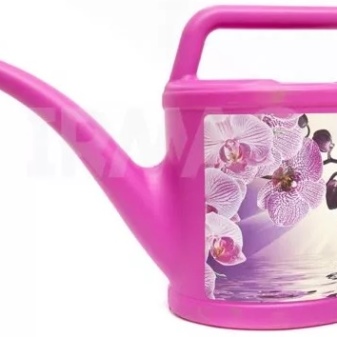
Perforation
Metal watering cans are decorated with perforation. In this case, special devices are used that pierce through patterns. In this way, both unpainted metal and painted models can be decorated.
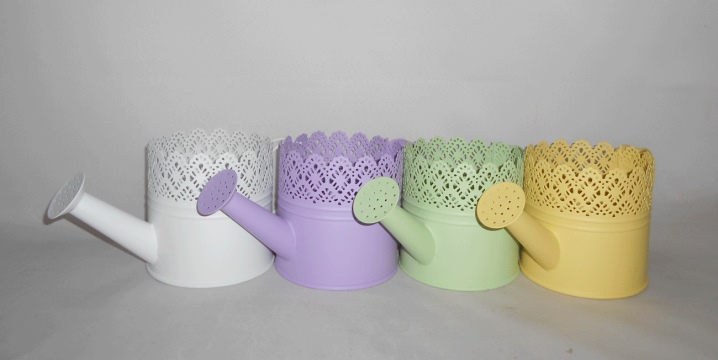
How to make decoupage of a watering can, see below.
What are they?
All watering cans on the market for garden tools can be divided into indoor and garden. Their main differences are the size and shape of the spout. Indoor varieties are not large in volume (up to three liters), while the spout is longer than the rest, so that you can easily reach hard-to-reach places. Room inventory is more varied in design, there are no requirements for aesthetic appeal to garden watering cans, since the conditions for their operation are much more complicated and over time they all lose their original appearance. The main thing is that the tool is practical, reliable and durable.
What is decoupage?
Decoupage refers to the technique of applying and fixing on any base any material with a pattern, which is subsequently varnished. As a rule, paper-based material is used. For the base, you can take almost any smooth object with a non-porous surface, without irregularities. For decoupage, both furniture and dishes, decor items, and household items are perfect.
Material on which you can safely decoupage:
- wood in any form: impregnated or not, sanded, unsanded, painted, unpainted, varnished;
- all types of plywood;
- plastic items with any surface: rough and smooth, painted and transparent;
- glass, faience, porcelain;
- metal.
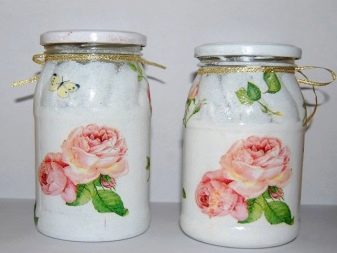
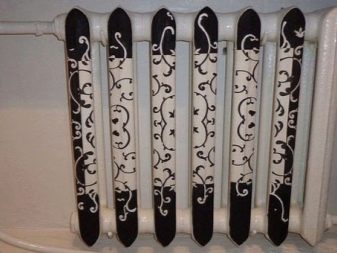
How to choose?
Having learned about the main types of watering cans from garden tools and their features, you can proceed to the direct selection of the required model.
You should carefully examine your favorite watering can. There should be no cracks or even minimal gaps on the product body
When choosing a metal unit, it is important to carefully check the seams. As everyone knows, a poorly welded seam can give a slight leak.
It is required to carefully consider the proposed nozzles
Any greenery, for example, dill or parsley, should be watered exclusively with the help of scattering nozzles. A strong stream of water will only wash out the garden, and the plants will die.
In order not to look for additional accessories, it is best to pay attention to models with sets of attachments.
Special attention should be paid to the design of the watering can spout. It should be located as close to the base of the liquid container as possible.
If there is a need to know the exact volume of the liquid used, you should choose models with divisions on the body.
For the convenience of viewing the remaining water, the watering can should not be dark in color, the best option is white, beige or yellow.
The volume of the vessel is an important consideration when choosing a suitable model. Watering cans of 10 or 12 liters are suitable only for physically strong gardeners. For representatives of mature age, models up to 8 liters are best suited.
Use minimum containers for watering outdoor hanging flower pots. It is convenient for them to scoop up water and raise them higher than their height.
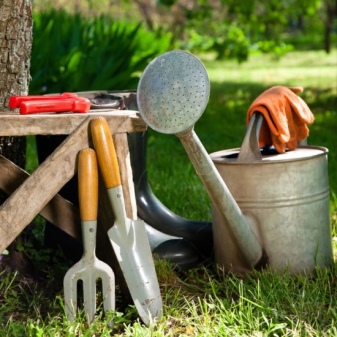
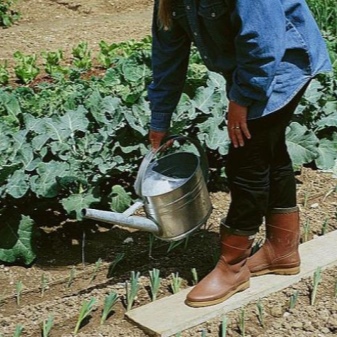
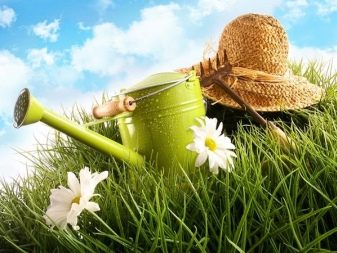
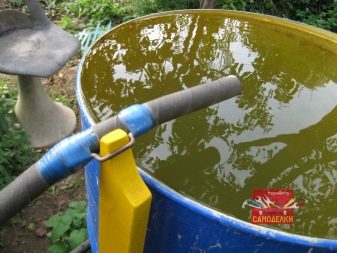
Recently, sets consisting of several watering cans and nozzles have become very popular.They differ in volume and size, the smallest one is suitable for watering indoor plants, but the medium and large ones are suitable for working in the garden and in the garden.
For how to quickly repair a garden watering can, see the next video.


